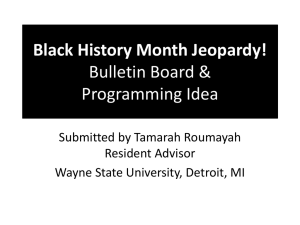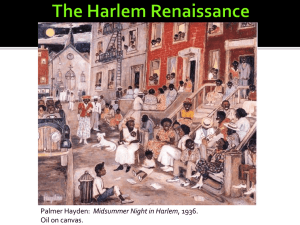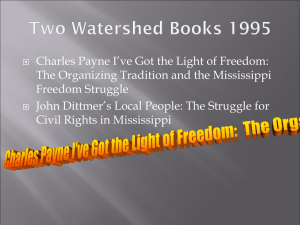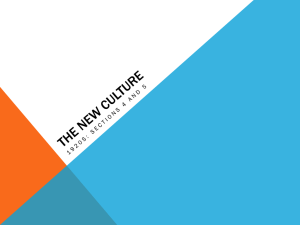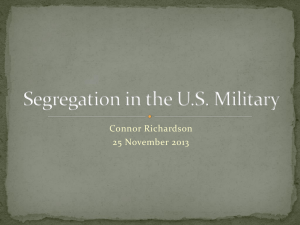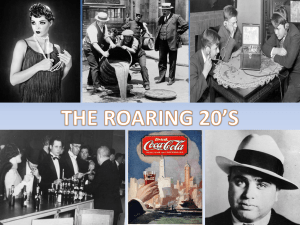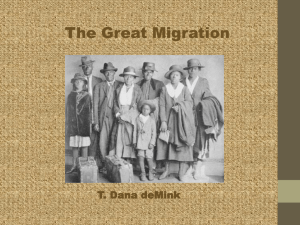chapter_20-the_jazz_age_1921-1929-section_3
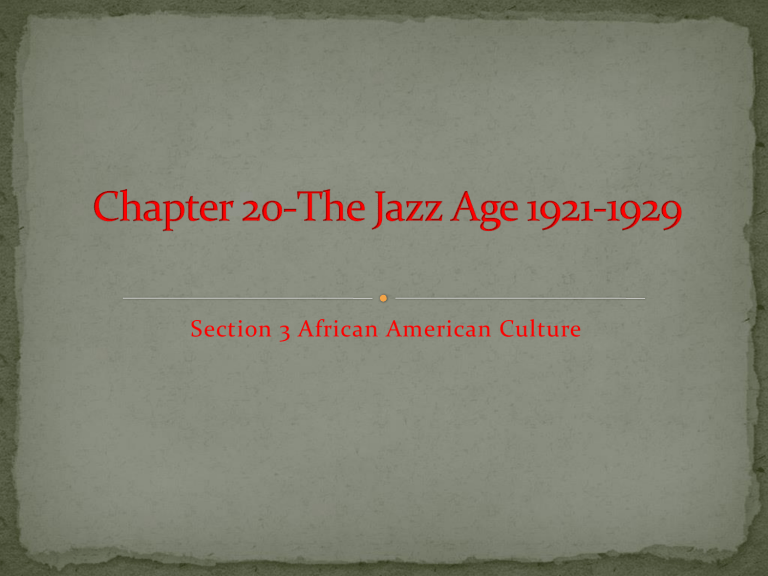
Section 3 African American Culture
Section 3-African American Culture
Click the Speaker button to listen to the audio again.
Chapter Objectives
Section 3: African American Culture
• I can describe the Harlem Renaissance and the rediscovery of African American cultural roots.
• I can explain the increase in African American political activism.
Click the mouse button or press the
Space Bar to display the information.
The Harlem Renaissance
• The Great Migration occurred when hundreds of thousands of African Americans from the rural
South headed to industrial cities in the North with the hope of a better life.
• In large northern cities, particularly New York
City’s neighborhood of Harlem, African Americans created environments that stimulated artistic development, racial pride, a sense of community, and political organization, which led to a massive creative outpouring of African American arts.
• This became known as the Harlem Renaissance.
(pages 626–628)
The Harlem Renaissance
(cont.)
• Writer Claude McKay became the first important writer of the Harlem Renaissance.
• His work expressed defiance and contempt of racism, which were very strong writing characteristics of this time.
• Langston Hughes became the leading voice of the African American experience in the United
States.
(pages 626–628)
Click the mouse button or press the
Space Bar to display the information.
The Harlem Renaissance
(cont.)
• Louis Armstrong introduced jazz , a style of
music influenced by Dixieland music and ragtime.
• He became the first great cornet and trumpet soloist in jazz music.
• A famous Harlem nightspot, the Cotton Club , was where some famous African American musicians, such as Duke Ellington , got their start.
(pages 626–628)
Click the mouse button or press the
Space Bar to display the information.
The Harlem Renaissance
(cont.)
• Bessie Smith sang about unrequited love, poverty, and oppression, which were classic themes in blues style music.
• This soulful style of music evolved from African
American spirituals.
Click the mouse button or press the
Space Bar to display the information.
(pages 626–628)
African American Politics
• After World War I, many African Americans wanted a new role in life and in politics.
• The Great Migration led to African Americans becoming powerful voting blocs, which influenced election outcomes in the North.
• Oscar DePriest was elected as the first African
American representative in Congress from a
Northern state after African Americans voted as a block.
(pages 629–630)
Click the mouse button or press the
Space Bar to display the information.
African American Politics
(cont.)
• The National Association for the Advancement of
Colored People (NAACP) battled against segregation and discrimination.
• The NAACP’s efforts led to the passage of antilynching legislation in the House of
Representatives, but the Senate defeated the bill.
(pages 629–630)
Click the mouse button or press the
Space Bar to display the information.
African American Politics
(cont.)
• Jamaican black leader Marcus Garvey’s idea of
“Negro Nationalism” glorified black culture and traditions.
• He founded the Universal Negro Improvement
Association (UNIA), which promoted black pride and unity.
• Garvey encouraged education as the way for
African Americans to gain economic and political power; but he also voiced the need for separation and independence from whites.
(pages 629–630)
Click the mouse button or press the
Space Bar to display the information.
African American Politics
(cont.)
• Garvey’s plan to create a settlement in Liberia in
Africa for African Americans caused middle class
African Americans to distance themselves from
Garvey.
• His ideas, however, led to a sense of pride and hope in African Americans that resurfaced during the civil rights movement in the 1960s.
(pages 629–630)
Click the mouse button or press the
Space Bar to display the information.
New Words The youth culture of the twenties produced a number of new words and phrases that became a part of their own language. In the mid-1920s, partygoers urged fellow dancers to “Get hot! Get hot!” Young Americans also invented such terms as beauts , cat’s pajamas , and cat’s whiskers to describe attractive young women. The terms lounge lizards , jelly beans , and jazzbos described attractive young men, while the phrase hard-boiled eggs described tough guys.
Prohibition also expanded American vocabulary. Bootlegger , speakeasy , and hip flask became part of common speech. It also gave new meaning to the words wet and dry .
The first Miss America was crowned in 1921. It seems fitting that sixteen-year-old Margaret
Gorman was from the nation’s capital–
Washington, D.C.
Charismatic preacher Aimee Semple McPherson gained added notoriety for a five-week disappearance she claimed was a kidnapping and for the many lawsuits filed against her in the following years, often for libel or slander.
Tennessee’s law against teaching evolution remained on the books until 1967.
Click the Speaker button to listen to the audio again.
All That Jazz The origin of the term jazz is one notable dispute in American English. It may have come from the word Chaz, the nickname of an early ragtime drummer named Charles
Washington, or from chasse, a kind of dance step. African and Creole sources are also possibilities.
